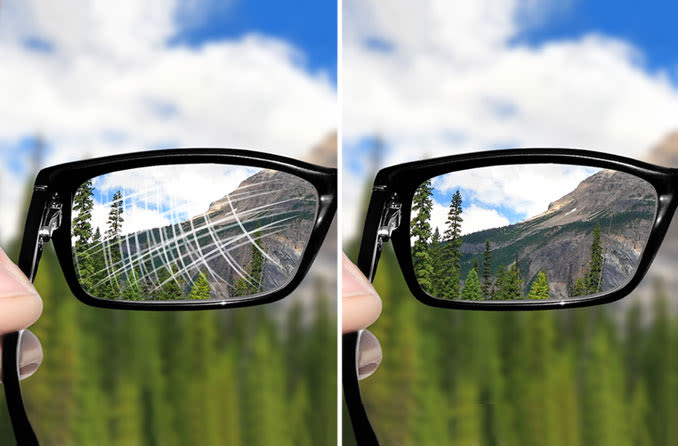Glasses lens coatings: So many choices!

Lens coatings can enhance the durability, performance and appearance of your spectacle lenses. This is true whether you wear single vision, bifocal or progressive lenses.
If you are thinking about purchasing new glasses, here are lens coatings and treatments you should consider.
Anti-reflection coating
Anti-reflection coating (also called AR coating or hard-multi coating) is a microscopically thin multi-layer coating that eliminates reflections from the front and back surface of spectacle lenses.
By doing so, an AR coating makes your lenses nearly invisible so people can focus on your eyes, not distracting reflections from your spectacles.
Anti-reflection coating also eliminates the sheen caused by light reflecting from your lenses. With reflections eliminated, lenses with an AR coating provide better vision for night driving and more comfortable vision for reading and computer use.
An AR coating is highly recommended for all spectacle lenses, but particularly for polycarbonate and high-index lenses. These lens materials reflect more light than regular glass or plastic lenses if an anti-reflection coating is not applied.
Also, aspheric lenses, which have a flatter appearance than regular lenses, often cause more noticeable reflections, so an AR coating is highly recommended for these lenses, too. Additionally, an AR coating is beneficial when applied to the back surface of sunglasses to eliminate "bounce-back" reflections when you are facing away from the sun.
For the best possible comfort in all lighting conditions, optometrists usually recommend applying an anti-reflection coating to photochromic lenses. AR coatings improve light transmission through the lenses for night driving and helps photochromic lenses reduce glare in bright sunlight.
[Read more about anti-reflection coating.]
Scratch-resistant coating
No spectacle lenses — not even glass — are scratch-proof.
However, lenses that are treated front and back with a clear, scratch-resistant coating have a much harder surface that is more resistant to scratching, whether from dropping your glasses on the floor or the fine scratching that can develop from cleaning the lenses when they're dry.
Childrens' lenses, especially, benefit from a scratch-resistant hard coat for greater durability.
Today, most spectacle lenses, including high-index lenses and lenses made of polycarbonate, have a built-in scratch-resistant coating.
Since scratch-resistant coatings are sometimes optional, make sure your optometrist knows that you want your spectacle lenses to include hard coating for extra durability.
Keep in mind that even the best scratch-resistant coating can't completely protect your lenses from wear and tear. To keep your glasses looking new, store them in a cushioned case when not in use, and clean your lenses with a microfibre cloth and the cleaning solution your optometrist recommends.
Also, be wary of products that promise to repair scratched lenses. These products may fill in the scratches, but it is impossible for them to make the scratches disappear, so the lenses look new again.
Anti-fog coating
If you live in a cold climate, or the steamy tropics nothing is more frustrating than having your spectacles fog up when you come in from the cold or when you go outside from an air-conditioned house. This also can be a safety issue, since it limits your ability to see until the fog clears.
Lens fogging can be especially dangerous for police officers and other emergency workers. More people are aware of this issue since the wearing of masks become more common during the COVID crisis.
Lens fogging is caused by tiny water droplets that form by condensation on the surface of spectacle lenses when the lenses are significantly cooler than the surrounding air temperature.
A number of companies make anti-fog sprays and coatings designed to reduce the condensation of moisture on lenses that causes fogging. So, your lenses and vision stay clear when you make the transition from a cold environment to a warm one.
Anti-fog coating also may keep your lenses from fogging up during sports and other times when you are hot and perspiring.
Anti-fog coatings can be applied to plastic, polycarbonate and other spectacle lenses, including high-index lenses and Transitions photochromic lenses. The coating is applied to the lenses before they are cut to fit into your frame at the optical lab. Ask your optometrist about availability.
Ultraviolet treatment
Another beneficial lens treatment is an invisible dye that blocks ultraviolet (UV) rays. Just as sunscreen keeps the sun's UV rays from harming your skin, UV-protective treatments for spectacle lenses block those same rays from damaging your eyes.
Overexposure to ultraviolet light is thought to be a cause of cataracts and other eye problems.
Hi-index spectacle lens materials, including polycarbonate and 1.6, 1.67 and 1.74 plastics, have 100 percent UV protection built-in, so an extra lens treatment is not required for these lenses. However, standard plastic spectacle lenses only block on 94% of UV rays, adding a UV-blocking dye boosts protection to 100 percent.
Photochromic lenses also block 100 percent of the sun's UV rays without the need for an added UV lens treatment.
Page published on Tuesday, 17 March 2020






